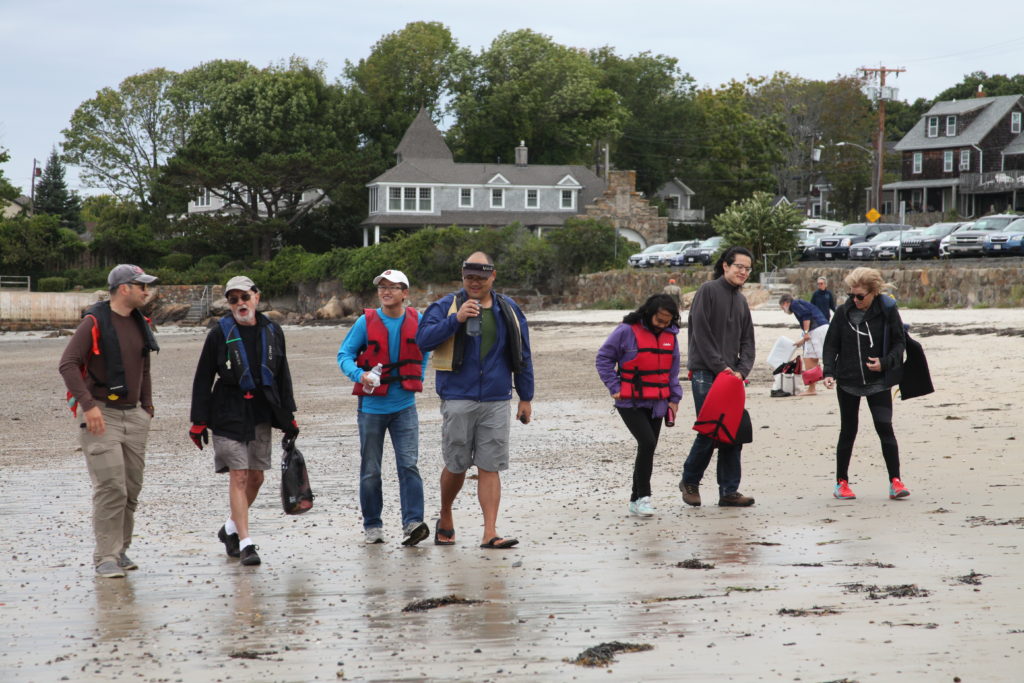BY Andrew Leung

Ka Ming Wong, Annette Grimes
On September 14, a race crew from VCB journeyed to Gloucester, MA to explore uncharted territory and compete in the Gloucester Harbor Race, a three and a half-mile open water event. While this was the eleventh iteration of the race, it is the first time VCB has sent a crew, and it would prove to be a learning experience for us.
Competitors in this race row in six oared pilot gigs, a notable departure from the four-oared Whitehalls based in Pier 40. These traditionally built boats feature solid wood planking and solid wood oars, totaling to a craft more than double the weight of our sturdy Whitehalls. Fortunately, we had a brief practice session in King Tide — our own lapstrake plank Cornish pilot gig — to give us an idea of what to expect.
Two groups of VCB rowers arrived in Gloucester Friday afternoon and evening and were welcomed into the home of our Gloucester Gig Rower (GGR) host. Situated within walking distance of Plum Cove Beach, we were advised that this was a popular spot to view sunset, and indeed it was!
On Saturday morning, the crew woke early to help GGR taxi their gigs from their pier to the race site at Niles Beach. Under the watchful eye of a GGR coxswain, we followed the long-stroke ideal for pilot gigs, but unfamiliar to us in Whitehalls. After this welcome practice row, there was race strategy to be discussed.
Fortunately, we were assigned to the third heat, so we were able to watch the first two groups launch. One of our rowers was a former GGR and recruited one of their racing coaches to give us a few pointers. After some deliberation and spirited discussion, we decided to adopt a stoke pace that was a compromise of our familiar Whitehall stroke and the new pilot gig stroke we had just learned.
When our turn to race came, we were assigned to the Annie B., a beautiful blue and orange pilot gig named after the founder of GGR. The race featured an on-water start, so we boarded our craft and eagerly waited for the starter’s pistol to sound and send us on our way. The wind was considerable and all boats in this heat rowed to stay in place, lest one of us prematurely cross the starting line and force a reset.
After the pistol sounded, we rowed southwest hard into a headwind, alongside another gig and with one chasing our tail. There wasn’t much separation in the pack as we raced towards the Dog Bar, a view tower at the end of a jetty protecting Gloucester Harbor from the pounding waves of the Atlantic. The two sharp turns in front of Dog Bar broke apart the pack, as none of the coxswains wanted to come into contact with the racecourse markers and take a time penalty. We slowed to take the turns single file and ended up as the second boat of three.
With about one-third of the racecourse behind us, we finally had the wind at our backs. How were we doing on time? None of us could tell you. Time has a habit of ceasing to exist during races, lost in the consistent stroke and words of encouragement shouted by the coxswain.
The final boat behind us on the course crept closer as we both stroked on towards Ten Pound Island. Our cox decided it was time to push for some separation before we went into the last turn north of this island to avoid being stuck on the outside of two turning gigs there. “Power ten!” he shouted. Then twenty. Then thirty. After we reached forty, one of our crew shouted “Unlimited power!” and was met with laughter from the crew. This plan worked, and we were able to reach the turn first and maintain the lead to the finish line.
Overall, VCB finished third in the men’s category and brought home a new medal for the trophy case. Not bad for fifteen minutes of practice. One might even say we did well, considering that our GGR coach told us it could take up to a year for new rowers to perfect the longer pilot gig stroke.
